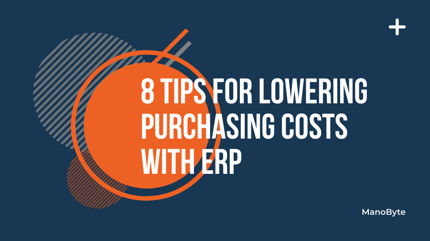8 Tips for Lowering Purchasing Costs with ERP
Chelsea Carter

Costs of raw materials and supplies rise and fall. They take up a massive percentage of any manufacturer's budget, but companies who learn how to buy and work efficiently can keep their costs lower regardless of the troubles facing the marketplace. Your ERP software supports you in this effort. What is ERP? It is Enterprise Resource Planning, and here are eight tips to leverage ERP to lower purchasing costs.
1. Reduce Human Error
You can use your ERP to centralize communications and processes. This way information only has to be entered once, often automatically utilizing ERP-integrated devices. This reduces the potential for human errors and improves how people work together up and down the line to cut purchasing costs.
2. Eliminate Bottlenecks
You can further use a modern ERP to identify and eliminate bottlenecks that put the team into a "hurry up and wait" scenario. One hand knows what the other is doing and can plan accordingly to maximize efficiency and productivity across the supply chain
This can lower purchasing costs by supporting your efforts to buy materials when needed, not too early, which increases holding or transportation costs, and not too late, which slows your production line.
3. Better Forecast Demand
Through ERP software with integrated IoT (Internet of Things), you can collect anonymous customer data that helps you better understand the customer buying cycle and forecast demand for various products on the manufacturing line. With this data, you can make smarter purchasing decisions in terms of what, when, and how.
4. Generate Mutually Beneficial Relationships
When people ask what is ERP, it's important to note that benefits extend beyond the company who has invested in the ERP software, and this can pay that company back in several ways. One of those is in the form of strengthened relationships with suppliers, transporters, warehouses, retailers, and other third-party entities who may be in your supply chain.
Speaking specifically in regards to lowering purchasing costs, you might consider this: because ERP software helps you forecast out over a greater time frame, you can create some very mutually beneficial relationships with vendors. They can depend on the regularity and consistency of your purchase orders. This helps them cut their own costs and better understand their own raw material needs. Now you can leverage that cost-savings for your vendor into discounts.
5. Get More Discounts for Large Purchase Orders
Suppliers often offer quantity discounts because they save on transportation, warehousing, production, marketing, and other costs. But if you have multiple departments or hubs ordering separately, you could be missing out on these discounts.
Your ERP software helps you better understand needs across your organization, multiple locations, and even continents. Your company can set up the ERP software to automatically consolidate orders over a given period of time to maximize discounts earned. And once again, having that longer forecasting horizon we discussed earlier means you may be able to consolidate more orders than you are able to envision today.
6. Make Smarter Buying Decisions
Some supplies are expensive. It probably wouldn't make sense to purchase more than you forecast you will need over a relatively short time frame, like a seven day period. You would be tying up too much cash. But what about less expensive consumables? You may be able to buy in larger quantities for a longer production window, say 30 days, to get the best discounts.
However, the complexity of buying decisions grows as you consider:
- Expiration dates
- Storage costs
- Sales data for Product A vs B
- Forecasted sales and customer trends
You may find yourself drawn to a scenario where you're always getting the best discount, but this isn't always the smart decision. An enterprise-wide ERP generates business intelligence based upon the whole picture so that a company isn't saving a dime here to spend a quarter over there.
7. Identify Supplier Quality Issues
The partnership between the manufacturer and supplier is a strong one. It's easy for the humans who work closely with these suppliers as well as those experiencing the rejects and reworks to overlook apparent supplier issues. They can't always see how much those issues are actually costing your company.
Are items getting rejected when received? Are faulty raw materials leading to an increase in finished products that don't meet quality standards? This costs you money. You can use your ERP to distinguish patterns versus one-off occurrences. On top of that, you have the data you need to meet with leadership at these companies to either correct issues or confidently begin looking for an alternative supplier.
One way to accomplish this would be to set up your ERP software to compare general ledger entries to actual production hours materials to identify inconsistencies.
8. Identify In-House Quality Issues
Re-do, reworks, rejects -- these all cost you money, but it's not always someone else's fault. They can occur for a variety of reasons in-house, such as:
- Human data or production error
- Outdated or malfunctioning assets
- Poor quality control earlier up the line
- Failure to properly store or retrieve
- Failures at goods-in inspection
Worse yet, often these problems don't become clear until the retailer or end-customer gets the item, resulting in:
- Returns
- Bad reviews
- No re-orders
- Lost trust all around
Fortunately, business leadership has maximum control over these areas. Your ERP software can provide you real-time data at each checkpoint in the line, so that you can identify where the breakdown is taking place and correct it.
How to Cut Purchasing Costs with ERP Software
ManoByte can help you identify areas where your ERP can help you save money. We can implement a customized, cloud-based ERP system across your organization and train your employees to get the most out of this software. If you're looking for a tool that can help you cut purchasing costs from many angles and digitally transform your business, please contact us to schedule a meeting.


